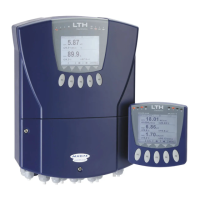Faults
MXD70 Conductivity Setup and
Operating Guide
- 55 -
Faults
Fault Finding
NOTE: THERE ARE NO USER SERVICEABLE PARTS INSIDE THE UNIT
The MXD70 Series has been designed to include a wide range of self diagnostic test, some of which are
performed at switch on, and some on a continuous basis. This guide aims to provide a route to
diagnosing and correcting any faults that may occur during normal operation. The table shown in
Appendix D Error Messages gives a list that the MXD70 series generates, along with their probable
causes. If the fault has not been cleared after these checks have been made contact LTH. Please have
as much of the following information available as possible in any communication with LTH, to enable
quick diagnosis and correction of the problem.
Serial number of the instrument,
The approximate date of purchase.
Details of the program settings and application
Electrical environment and supply details
Circumstances under which the fault occurred.
The nature of the fault or faults
Any error messages that are displayed
The sensor type, cable length and type
Current output configuration
Relay connection configuration
It is often worthwhile to check the measurement by an independent method, for example using a
handheld meter. (See also Care and Maintenance of Conductivity Sensors, page 7)
Note: low conductivity = high resistivity
The Instrument Appears Dead
Check that power is available to the unit. Using a voltmeter, set to AC or DC, check the power supply
voltage at the connector. The design of the MXD70 Series allows the unit to accept from 85 to 250V AC
or DC, an alternative option allows operation from 18 to 32V AC or DC, check the connection label for
voltage specification. Check that the power cable is securely and correctly attached. There are no user
serviceable fuses fitted within this unit.
The Access Code Does Not Work
It is probable that the access code has either been changed or the operator does not recall the code
correctly. Contact LTH or your local distributor should this problem arise.
The Sensor Reading Is Constantly Over-range or Under-range
Ensure that the sensor and temperature inputs are correctly connected (see Installation and Choice
of Conductivity Sensors, page 7) and that the sensor is not faulty or damaged.
Check that the correct range and Cell Constant has been selected within the Channel Setup menu if
in doubt set to Auto Range (see page 16).
Check the temperature compensation state (see Channel Setup page 18). If the compensation is set
to “Manual” check that the fixed temperature is at the correct level. If the compensation is
“Automatic” check that the temperature reading on the main display is correct.
Check the sensor using a hand held meter.
Check that the sensor is “seeing” a representative sample, trapped air will give a low reading.
Ensure the input is correctly connected and the sensor is not faulty or damaged.
Check the sensor and its cable for possible short circuits. Consider the fact that the conductivity may
be higher than the range of the instrument.

